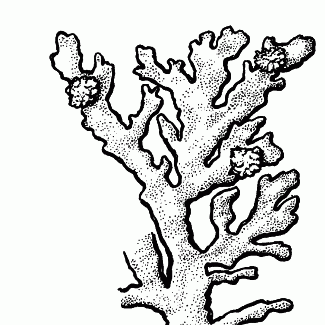Xanthoparmelia mougeotii (Schaerer) Hale
Powdered rockfrog
Parmeliaceae
Introduction to the Lichens
Powdered rockfrog
Parmeliaceae
Introduction to the Lichens
Map
Distribution of Xanthoparmelia mougeotii unavailable
Species Information
General:
Common Name: The Rockfrog Lichens. Suggested by the greenish colour of the upper surface, as well as the strict association with rock surfaces.
Small to large stratified foliose lichens, corticate above and below, sorediate or isidiate or not, lobes tightly appressed to semi-erect, elongate to elongate-linear, averaging to 0.5–5 mm wide, thin to somewhat thickened. Upper surface pale yellowish green, K-, rarely white-maculate, somewhat shiny. Lower surface pale to black, somewhat shiny, bearing scattered short, simple or sparingly branched rhizines. Medulla white (ours). Photobiont green.
Apothecia located over upper surface, disc brown; spores simple, ellipsoid, colourless, 8 per ascus.
Over rock, rarely over soil or moss.
Notes: Xanthoparmelia contains about 400 species worldwide, of which 51 species occur in North America and eight in B.C. Xanthoparmelia is taxonomically the most difficult of the genera previously united within Parmelia. Reliable identification of many species depends on a knowledge of the chemical substances they contain. Though this is most reliably attained through use of thin-layer chromatography, the chemistry of the B.C. Species can usually be surmised from the medullary reaction with K. Two character states are recognized: K+ finally reddish orange or orangish red (i.e., salazinic acid present), and K+ finally yellow or medium orange (stictic acid present). The distinction between these two reactions can be subtle, depending on the concentration of the chemical substances. In difficult cases, intensify the reaction by applying a second drop of reagent to the test site.
Species description:
Thallus sorediate or isidiate AND
Thallus sorediate AND
Lower surface usually somewhat shiny, not at all white-pruinose; upper surface shiny or dull; medulla KC+ reddish or KC- AND
Broadest lobes averaging to less than 1.5 mm wide; rhizines rarely, if ever, branched AND
Upper surface generally shiny throughout, transversely cracked when mature; coastal; over rock; medulla K+ finally yellow to medium orange, PD+ pale orange
Reactions:
Cortex KC+ yellow; medulla K+ yellowish, PD+ orangish.
Contents:
Constictic, norstictic, stictic and usnic acids.
Source: Lichens of British Columbia
Illustration

If more than one illustration is available for a species (e.g., separate illustrations were provided for two subspecies) then links to the separate images will be provided below. Note that individual subspecies or varietal illustrations are not always available.
Illustration By: Trevor Goward
Habitat and Range
Habitat: Frequent over acid rock in somewhat sheltered coastal localities (CDF zone)World Distribution: western N Am – western Eurasia, N to BC, S to CO.
Source: Lichens of British Columbia
Status Information
Synonyms
Synonyms and Alternate Names:
Parmelia mougeotii Schaerer